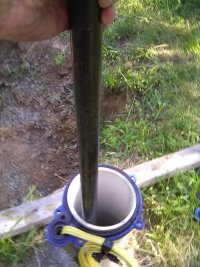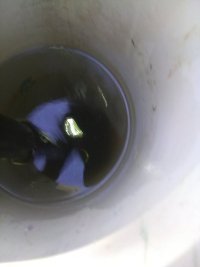Showme
New Member
We're building a new house here in southeast Missouri that's located on a pine ridge that's the end of a cascading slope from a nearby mountain. We knew when we bought the property (43 acres) that there were a lot of seeps and spots where surface puddles seemed to last longer than other spots. When we talked to the neighbor about a quarter mile away, he said his well was at 600', and another neighbor down from him was 630'. Knowing that a lot of this area lies over granite, we were sweating the cost of drilling through 600' of the hard stuff.
We had a local driller come out and check the place we needed the well. He "witched" the area, and marked about 5 places, but showed me one that he said was stronger than the rest, and let me sample what he was feeling with the stick. It literally skinned my palms where i was holding it. I said that's the one, and he came back a few days later with his rig and helper and started to drill.
A few days later he called me and asked me if i could come down to the site. He needed to show me something, he said. I was already on my way there from home (a 40 minute drive), and asked him if this was bad news? He said no, but i needed to come.
When i got there, water was gushing out of the trough he had set up to measure the output. I asked him if that was water he was pumping in, or is that from the well? He said there wasn't any water being pumped in, and he told me he couldn't even measure it, it was coming out so fast. He guessed it was 120gpm, but said he was going to document it at 80 because he couldn't verify it. When he put the gallon container he used to time it with, it was full in less than a second.
I asked how deep? He said they hit water at 175' and couldn't drill any farther than 180' because of back pressure. I was amazed. And overjoyed. $12 per foot normal, and $14 per foot when they encounter granite. He said it was 10' of soil followed by sandstone, granite, flint then more granite.
This all leads to my question- We are now ready to install our pump (Grundfoss SQFlex 6), and it's time to drill the hole and install the pitless adapter, which will sit initially at 2' below ground level, and will have some added when we build our earth home (underground, except for the south face), which will have a back slope running towards the well head. The well head will be surrounded by concrete pipe or a wall.
Anyway, as things are now, the pitless adapter will be about 2 1/2' below the static line. First, what is the reason for the water level being this high? I've heard talk of artesian springs causing this, which i would say is a good thing. Is there something else that might allow this to happen?
Secondly, what's going to (probably) happen when i open up the hole for the adapter? Will it just drain out what's above the hole, or am i looking at a running stream into my work hole? If this is the case, I'll need to dig a ditch to the downslope to let it out. I plan on trenching the path to the house, then on to the garden spot for a hydrant there anyway, which are both down hill from the well head, but I'd like to know now if it may keep coming out until i get the adapter in and the hydrant that will be next to the well head installed. If there's a good possibility it will continue to come up and out of the well, I'll need to trench it now instead of when i'm ready to build the house.
Thanks for any and all comments and ideas on this. I've done a lot of searching but haven't found anything on this "good" problem of having water in the casing 6" above ground level. Lee
We had a local driller come out and check the place we needed the well. He "witched" the area, and marked about 5 places, but showed me one that he said was stronger than the rest, and let me sample what he was feeling with the stick. It literally skinned my palms where i was holding it. I said that's the one, and he came back a few days later with his rig and helper and started to drill.
A few days later he called me and asked me if i could come down to the site. He needed to show me something, he said. I was already on my way there from home (a 40 minute drive), and asked him if this was bad news? He said no, but i needed to come.
When i got there, water was gushing out of the trough he had set up to measure the output. I asked him if that was water he was pumping in, or is that from the well? He said there wasn't any water being pumped in, and he told me he couldn't even measure it, it was coming out so fast. He guessed it was 120gpm, but said he was going to document it at 80 because he couldn't verify it. When he put the gallon container he used to time it with, it was full in less than a second.
I asked how deep? He said they hit water at 175' and couldn't drill any farther than 180' because of back pressure. I was amazed. And overjoyed. $12 per foot normal, and $14 per foot when they encounter granite. He said it was 10' of soil followed by sandstone, granite, flint then more granite.
This all leads to my question- We are now ready to install our pump (Grundfoss SQFlex 6), and it's time to drill the hole and install the pitless adapter, which will sit initially at 2' below ground level, and will have some added when we build our earth home (underground, except for the south face), which will have a back slope running towards the well head. The well head will be surrounded by concrete pipe or a wall.
Anyway, as things are now, the pitless adapter will be about 2 1/2' below the static line. First, what is the reason for the water level being this high? I've heard talk of artesian springs causing this, which i would say is a good thing. Is there something else that might allow this to happen?
Secondly, what's going to (probably) happen when i open up the hole for the adapter? Will it just drain out what's above the hole, or am i looking at a running stream into my work hole? If this is the case, I'll need to dig a ditch to the downslope to let it out. I plan on trenching the path to the house, then on to the garden spot for a hydrant there anyway, which are both down hill from the well head, but I'd like to know now if it may keep coming out until i get the adapter in and the hydrant that will be next to the well head installed. If there's a good possibility it will continue to come up and out of the well, I'll need to trench it now instead of when i'm ready to build the house.
Thanks for any and all comments and ideas on this. I've done a lot of searching but haven't found anything on this "good" problem of having water in the casing 6" above ground level. Lee
Last edited:



